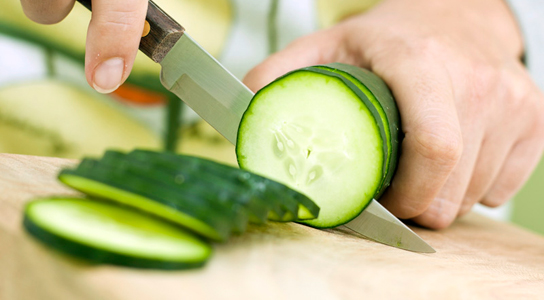
Washing a knife between cutting different produce items can stop viral cross-contamination. Credit: iStockphoto/Thinkstock
According to a new study, cutting unclean fruits and vegetables can spread viruses to the knife. Scienitists already knew that bacteria could contaminate utensils this way, but this is the first study to see if the hepatitis A virus and norovirus can be transmitted this way.
The scientists published their findings in the journal Food and Environmental Virology. These findings could help food safety investigators pinpoint the source of foodborne illnesses and develop new methods to prevent future outbreaks. The researchers set up a test kitchen and developed techniques to strip viruses off knives and graters. They measured the amount of hepatitis A virus or norovirus transferred from contaminated honeydew melons, cantaloupes, tomatoes, strawberries and cucumbers.
Regardless of the material and the sharpness of the knife used, more than half of all samples transferred viral particles to the knife. Some combinations of viruses and produce were more likely to contaminate knives than others. Norovirus was transferred more often from strawberries and cucumbers than hepatitis A, while melons and tomatoes transferred more hepatitis A than norovirus. Similar experiments on viral transfer from carrots to a grater found cross-contamination the majority of the time.
The scientists then tested whether contaminated knives could transfer viruses to clean fruits and vegetables, finding that at least seven produce items could be contaminated by a single contaminated knife. The results indicate that foodborne viruses are just as likely to spread to utensils as bacteria are. Since other studies have shown that fewer than 20 norovirus particles are needed to make someone sick, the viral knife contamination could cause illness.
This data is useful for commercial kitchens, where many produce items bound for different meals are being simultaneously chopped. It’s recommended that people wash their hands and utensils in between chopping produce items.
Reference: “The Fate of Murine Norovirus and Hepatitis A Virus During Preparation of Fresh Produce by Cutting and Grating” by Qing Wang, Marilyn Erickson, Ynes R. Ortega and Jennifer L. Cannon, 4 December 2012, Food and Environmental Virology.
DOI: 10.1007/s12560-012-9099-4









Sharpness of knife can cut no ice on viruses. They are extremely small when compared to even unicellular bacteria, like a mouse to an elephant. Viruses are the first chemistry turned biology of earth and they will outlive all biology. Thank You.
A good reason to keep on top of your knife maintenance and also replace the utensils from time to time.